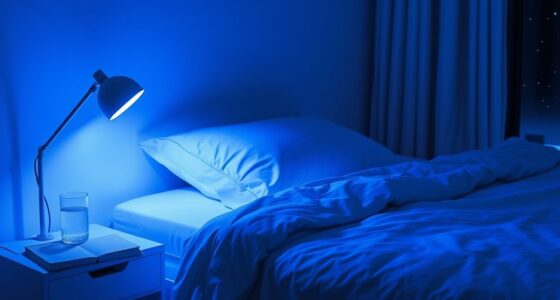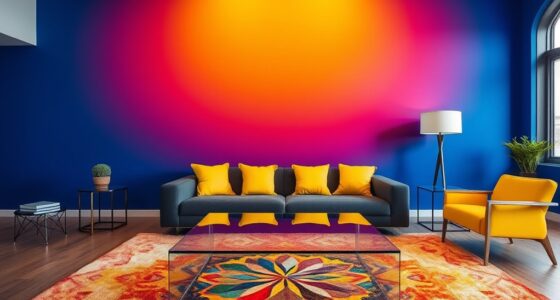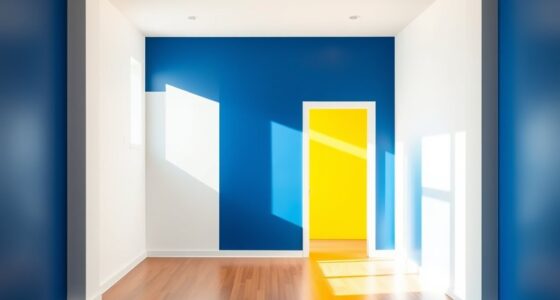Using color theory, you can create a sleep-friendly environment by choosing calming shades like blue, green, or lavender that promote relaxation and reduce stress. Soft, warm lighting further enhances these hues, signaling your body to wind down. Avoid bright, clashing colors or harsh lights that disrupt your circadian rhythm. By combining the right colors and lighting in your space, you set the stage for better sleep—discover how to optimize your environment even more.
Key Takeaways
- Soft, muted colors like blue, green, and lavender promote relaxation and reduce mental stimulation, aiding better sleep.
- Warm lighting tones such as amber and reddish hues signal the body to wind down, supporting melatonin production.
- Using calming color schemes in bedroom decor creates a peaceful environment that encourages restful sleep.
- Eliminating visual clutter and chaotic colors minimizes stress and mental distractions, improving sleep quality.
- Combining color psychology with proper lighting and organization fosters a holistic sleep-friendly environment.
Understanding the Connection Between Color and Relaxation
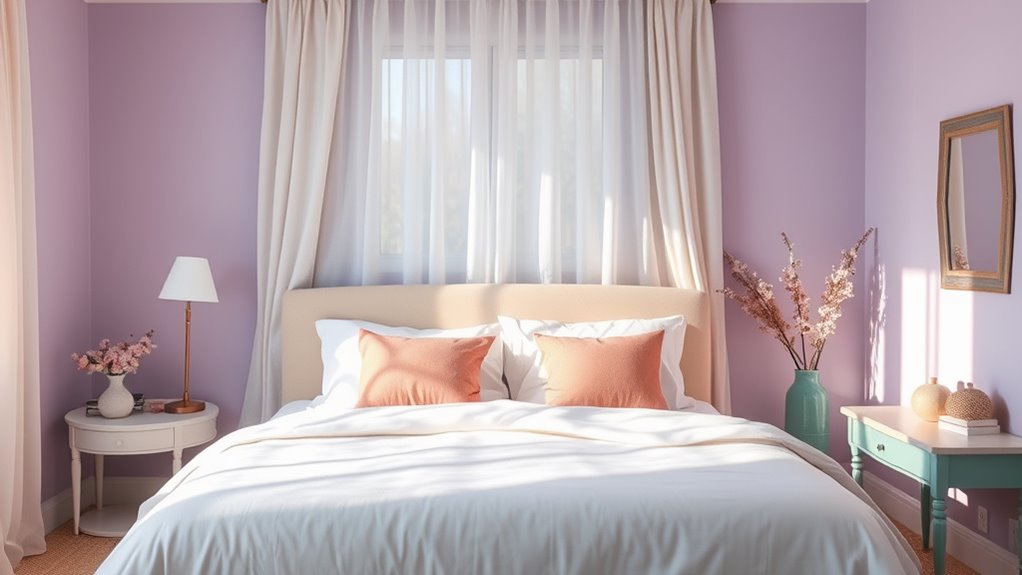
Since colors can influence our mood and emotions, understanding their impact on relaxation is essential for creating a calming sleep environment. Color psychology reveals how different hues can evoke specific feelings, affecting your ability to unwind. Soft, muted tones tend to promote visual relaxation by reducing stimulation and calming your mind. For example, gentle shades like blues and greens are often associated with tranquility and serenity, making them ideal choices for sleep spaces. Additionally, participating in internal company hackathons can foster innovative ideas for creating personalized sleep environments that incorporate calming colors. By choosing colors that foster a sense of calm, you help create an environment where your mind can relax more easily. Recognizing how color influences emotions allows you to harness visual relaxation intentionally, making your bedroom a true sanctuary for restful sleep.
The Best Colors to Promote Calmness and Sleep
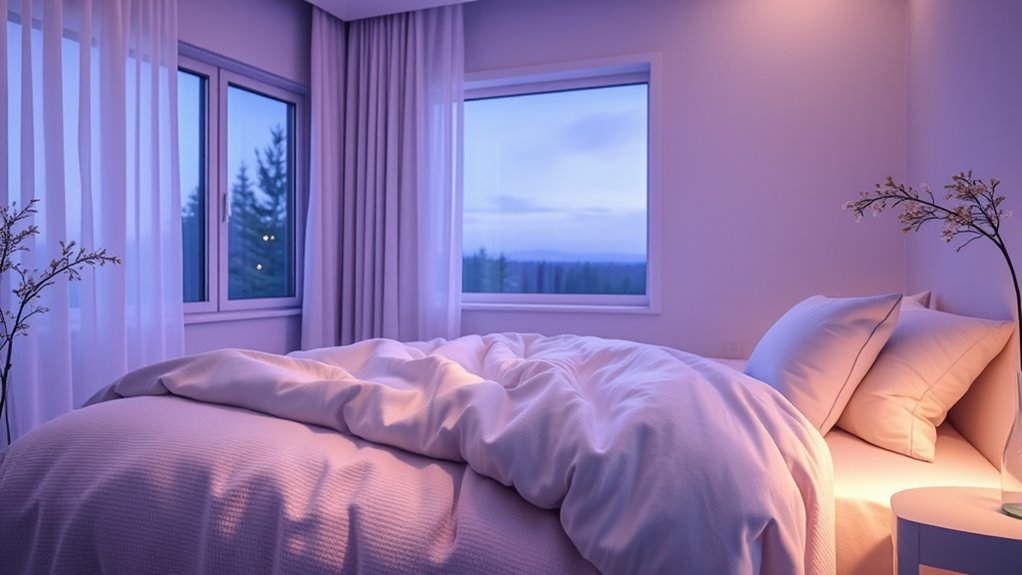
When selecting colors for your bedroom to promote calmness and sleep, certain hues stand out as particularly effective. Color psychology shows that soft, muted shades can markedly enhance your sleep environment by reducing stress and creating a tranquil atmosphere. Blues and greens are top choices because they evoke feelings of serenity and relaxation, making it easier to unwind at night. Light neutrals like pale gray or gentle beige also work well, providing a soothing backdrop without overstimulation. These colors help your mind associate the space with peace and rest, supporting better sleep quality. Additionally, choosing vetted Halloween products that include calming color schemes can contribute to a more restful environment during holiday celebrations. By choosing calming tones based on color psychology, you set the stage for a more restful night and a peaceful sleep environment.
How to Use Color in Your Bedroom Decor
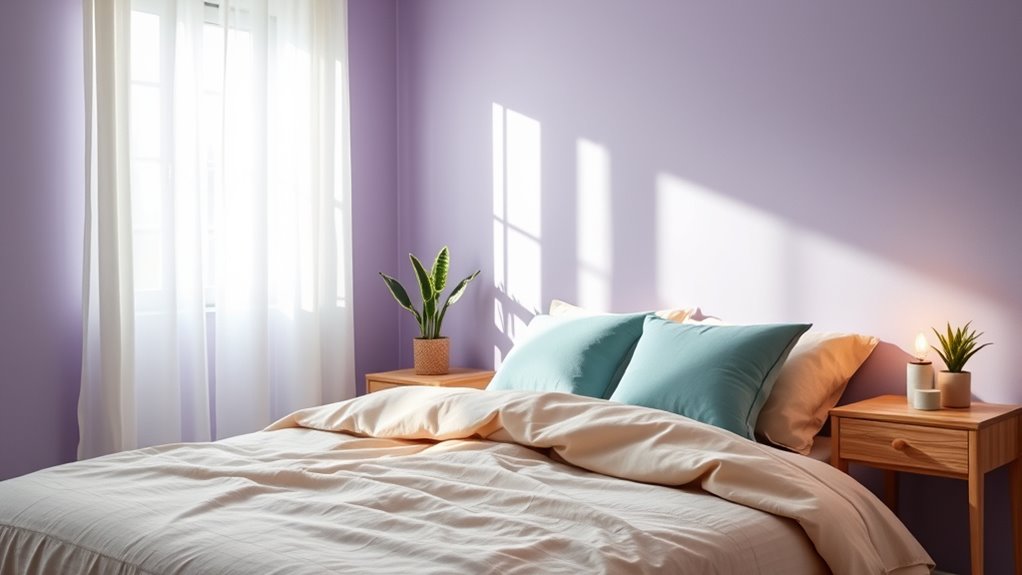
To effectively use color in your bedroom decor, start by choosing a palette that promotes relaxation and aligns with your personal style. Color psychology plays a vital role here, as certain hues can influence your mood and sleep quality. Soft, muted tones like blues, greens, and neutrals enhance bedroom aesthetics by creating a calm environment. Avoid overly bright or intense colors, which can be stimulating and disrupt your sleep. Incorporate these calming shades into your walls, bedding, and accessories to foster a peaceful atmosphere. Balance is key, so combine different shades thoughtfully to avoid visual clutter. Additionally, staying informed about Personal debt forgiveness bills can help you manage your finances better, reducing stress and creating a more restful space. By selecting colors that support relaxation, you’ll craft a welcoming space that not only looks great but also helps you unwind and sleep better each night.
The Impact of Lighting and Color Temperature
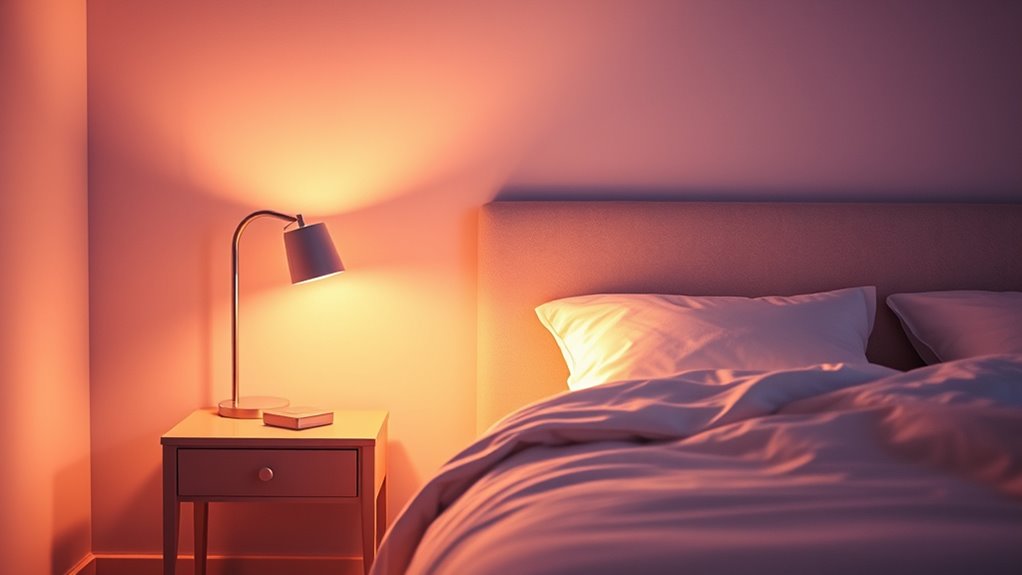
Your lighting choices can profoundly affect your sleep, especially regarding brightness and color temperature. Bright lights can disrupt your sleep cycles, while warmer tones promote relaxation and prepare you for rest. Understanding the differences between warm and cool tones helps create a calming environment that supports better sleep. Additionally, choosing freshly prepared juice over processed options can ensure maximum benefit and minimize exposure to spoilage indicators.
Brightness and Sleep Cycles
Lighting and color temperature profoundly influence your sleep cycles by regulating your circadian rhythm. Brightness levels and hue variations affect how alert or sleepy you feel, making it essential to manage lighting in your environment. High brightness and intense color saturation can signal daytime, suppressing melatonin production and delaying sleep. Conversely, dim lighting with softer hue variations promote relaxation and prepare your body for rest. Adjusting brightness strategically helps synchronize your internal clock, ensuring restful sleep. Using dim, muted lighting in the evening minimizes disruptions. By understanding how different light intensities and saturation levels impact your alertness, you can create a sleep-friendly environment that supports healthy circadian rhythms and improves your overall sleep quality. Incorporating warm, natural materials like linen and wood in your bedroom can further enhance relaxation and help reinforce your sleep cues.
Warm vs. Cool Tones
Warm and cool tones in lighting can markedly influence your sleep quality by affecting your body’s internal clock. Warm tones, with their reddish and amber hues, evoke relaxation through color psychology, signaling winding down. Cool tones, featuring blue and green hues, are associated with alertness due to hue psychology, making them less ideal before bed. The color temperature of your lighting impacts melatonin production, the hormone regulating sleep. Using warm light in the evening helps your body prepare for sleep by promoting calmness, while cool light can hinder this process. Understanding how warm versus cool tones influence your mood and sleep can help you create a lighting environment that fosters restful sleep. Choose lighting that aligns with your sleep goals to optimize your nightly rest.
Practical Tips for Incorporating Soothing Hues

Incorporating soothing hues into your sleep environment can profoundly enhance relaxation and promote better rest. Start by understanding color psychology; opt for colors like soft blues, gentle greens, or muted lavenders, which evoke calm and tranquility. When selecting hues, focus on hue selection that aligns with these calming effects—avoid overly bright or intense colors that can stimulate your mind. Use these shades in your bedding, wall paint, or accessories to create a cohesive, restful atmosphere. Keep lighting soft and warm, as it complements soothing colors and enhances relaxation. Simplify your space by minimizing clutter and distractions, allowing the calming hues to take center stage. Additionally, understanding ethical hacking principles can help you secure your sleep environment from digital disturbances or intrusions. With mindful hue selection, you can craft a sleep space that naturally encourages unwinding and restful sleep.
Common Mistakes That Disrupt Your Sleep Environment
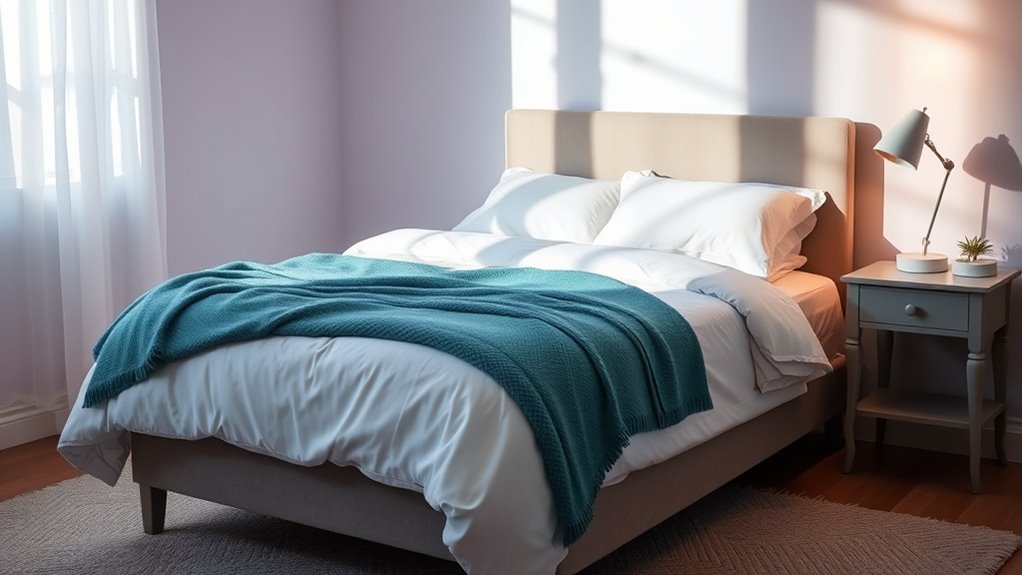
Bright lighting can make it hard to fall asleep, so keeping your room dim is essential. Clashing wall colors and cluttered spaces create visual chaos that can disrupt your rest. Avoid these common mistakes to create a more restful sleep environment. Incorporating attention in creative practice can help you become more aware of how your surroundings affect your sleep quality.
Overly Bright Lighting
Overly bright lighting in your sleep environment can considerably disrupt your ability to fall asleep and stay asleep. Bright light, especially with high color saturation, tells your brain it’s daytime, making it harder to wind down. Here are three consequences:
- You struggle to relax, feeling tense instead of calm.
- Your sleep cycle becomes irregular, leaving you exhausted.
- Your mood suffers, leading to irritability and stress.
- Using the right lighting concentrations can help create a calming atmosphere. Reducing light intensity and choosing softer, warmer bulbs can help. Avoid harsh, overly bright lighting before bed, as it sends false signals to your brain that it’s time to be alert. Instead, opt for dim, soothing light to encourage melatonin production and improve sleep quality.
Clashing Wall Colors
Clashing wall colors can markedly disrupt your sleep environment by creating visual tension that keeps your mind alert. In interior design, choosing colors based on color psychology is essential for fostering relaxation. When walls feature contrasting or chaotic hues, your brain struggles to find calm, making it harder to unwind. Sharp color clashes can evoke feelings of agitation or stress, undermining the peaceful atmosphere you need for restful sleep. Instead, opt for harmonious color schemes that promote tranquility, such as soft neutrals or muted tones. Simplifying your wall colors creates a soothing backdrop that encourages relaxation. Additionally, understanding color psychology can help you select hues that actively promote calmness and restfulness. Remember, the goal is to craft an environment that signals rest and calm—clashing colors work against that, disrupting your sleep quality from the moment you turn off the lights.
Cluttered Sleep Space
A cluttered sleep space can substantially interfere with your ability to relax and fall asleep easily. When your sleep environment is chaotic, it heightens stress and distracts your mind. Clutter triggers negative emotions like frustration, anxiety, and overwhelm, making it harder to unwind. To improve, consider these steps:
- Clear surfaces to create a calming, visually pleasing space.
- Use color psychology to choose soothing hues that promote tranquility.
- Keep only essential items in your bedroom to foster a sense of order and peace.
A tidy, thoughtfully arranged sleep environment reduces mental clutter and encourages restful sleep. Your space’s visual harmony directly impacts your ability to relax, so prioritize simplicity and serenity. A well-organized, color-coordinated bedroom sets the tone for better sleep every night.
Combining Color Strategies With Other Sleep-Enhancing Habits
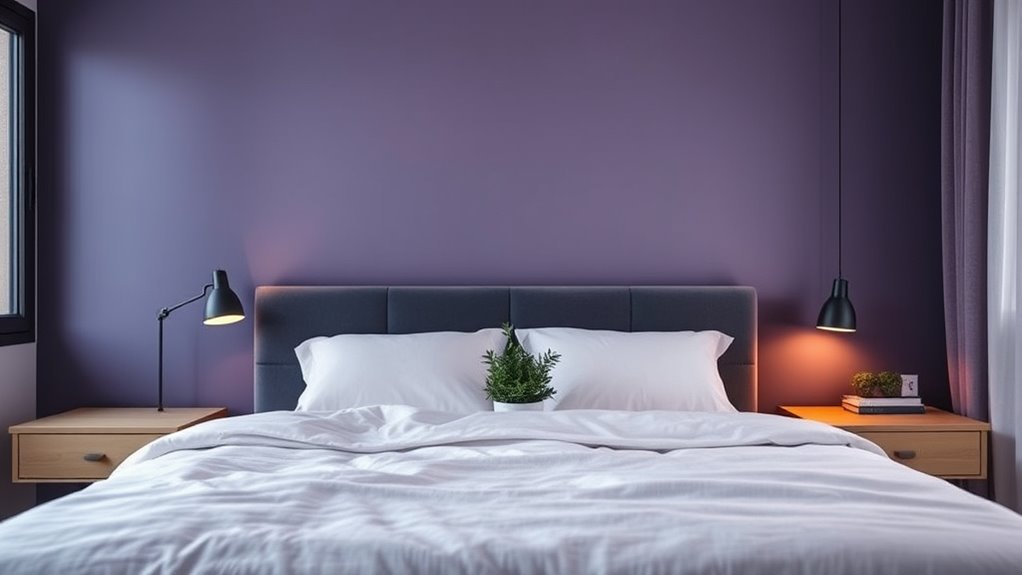
Integrating color strategies with other sleep-enhancing habits can create a powerful routine that promotes better rest. Your sleep environment plays a vital role, so choose calming colors like soft blues or gentle greens to set the tone. These colors can complement your sleep routine by signaling relaxation and tranquility. Pair color choices with consistent habits, such as dimming lights an hour before bed or avoiding screens, to reinforce your sleep signals. Consider using colored lighting or decor that aligns with your desired sleep atmosphere. When you combine thoughtful color strategies with habits like maintaining a regular schedule and creating a cool, dark room, you maximize your chances of falling asleep faster and enjoying deeper rest. Additionally, incorporating wall organization systems can help create a clutter-free and serene space conducive to sleep. This holistic approach helps establish a peaceful, sleep-friendly environment.
Frequently Asked Questions
Can Specific Shades of the Same Color Affect Sleep Differently?
Different shades of the same color can definitely affect your sleep differently. Shade psychology reveals that lighter hues, like soft blue or gentle lavender, promote relaxation and calmness, helping you drift off easily. Conversely, darker shades may feel more intense or stimulating, potentially disrupting your sleep. The hue impact varies based on your personal associations, but generally, choosing soothing shades can improve your sleep environment.
Are There Cultural Differences in Color Preferences for Sleep Environments?
You’ll find that cultural symbolism and regional preferences influence color choices for sleep environments. In some cultures, calming blues symbolize peace, while in others, warm reds evoke comfort. These cultural differences shape what feels relaxing or restful to you. By understanding these regional preferences, you can select colors that align with your background, creating a sleep space that feels both familiar and soothing, helping you relax more effectively at bedtime.
How Long Does It Take for Color Changes to Impact Sleep Quality?
Studies show color adaptation can influence sleep within just a few days. When you change your environment’s colors, it typically takes about one to two weeks to see noticeable sleep improvements. Your brain gradually adjusts to these new cues, promoting relaxation and better rest. So, if you want to enhance your sleep quality, give your eyes and mind enough time for color adaptation to work effectively.
Can Color Therapy Replace Traditional Sleep Aids Effectively?
Color psychology can enhance your sleep environment, but it shouldn’t replace traditional sleep aids. While calming hues like blue or green may promote relaxation, relying solely on color therapy isn’t enough for everyone. You might find it helps improve sleep quality, yet combining it with proven methods remains best. Think of color therapy as a supportive tool, not a complete substitute, ensuring you get restful, rejuvenating sleep.
What Are Affordable Ways to Incorporate Calming Colors Into Existing Rooms?
Did you know that calming colors like blue and green can improve sleep quality by up to 20%? To incorporate these colors affordably, try DIY paint ideas such as accent walls or painted furniture. Use affordable decor tips like soft bedding, curtains, or wall art in soothing shades. These simple changes help create a tranquil environment that promotes better sleep without breaking the bank.
Conclusion
Think of your bedroom as a sanctuary where color acts like a gentle lullaby, coaxing your mind into relaxation. By choosing calming hues and mindful lighting, you create a cocoon of tranquility that whispers sweet dreams. When you master these color strategies, you’re not just decorating—you’re orchestrating a symphony of serenity that guides you effortlessly into restful sleep. Embrace these hues, and let your environment become the peaceful haven you deserve.



